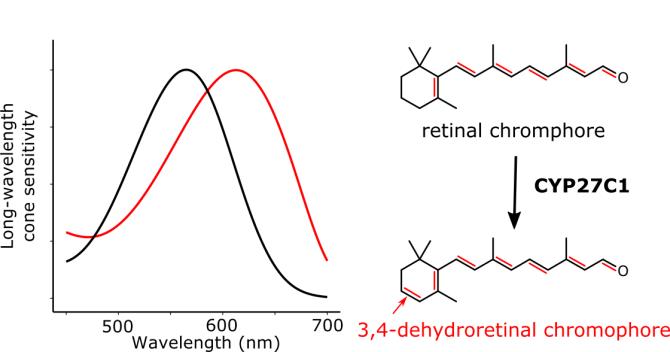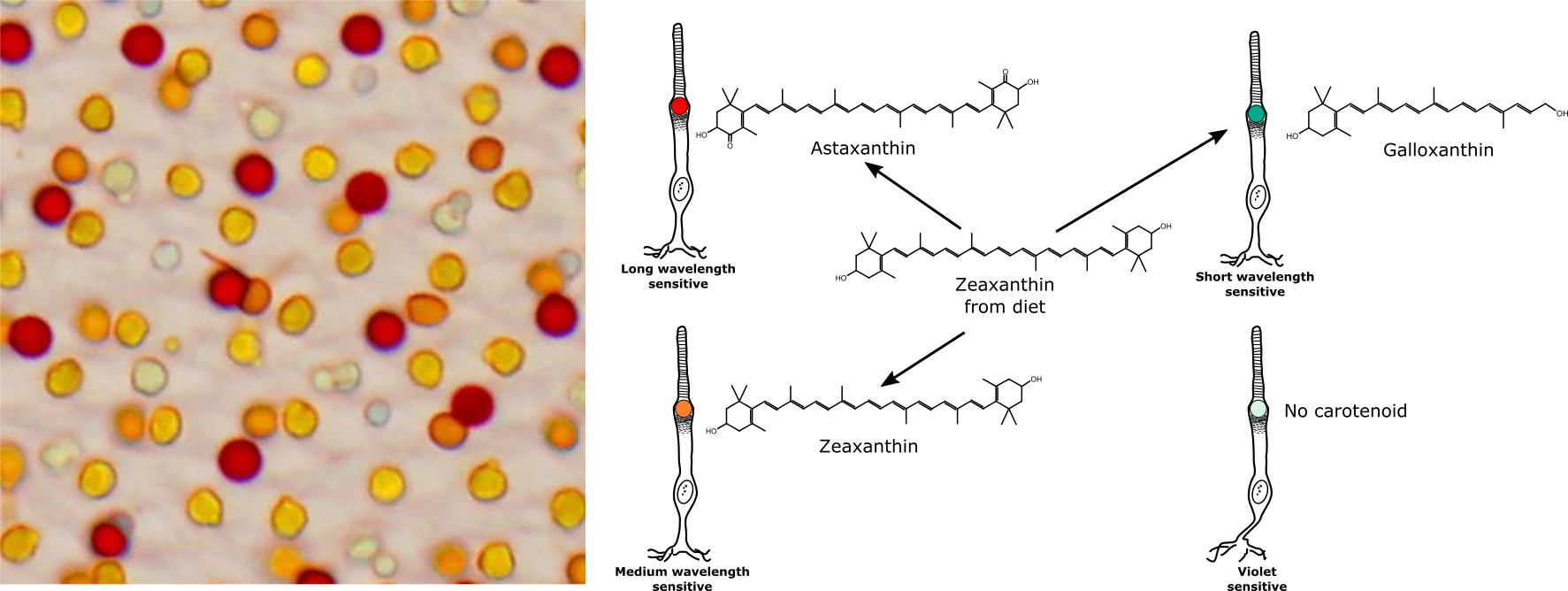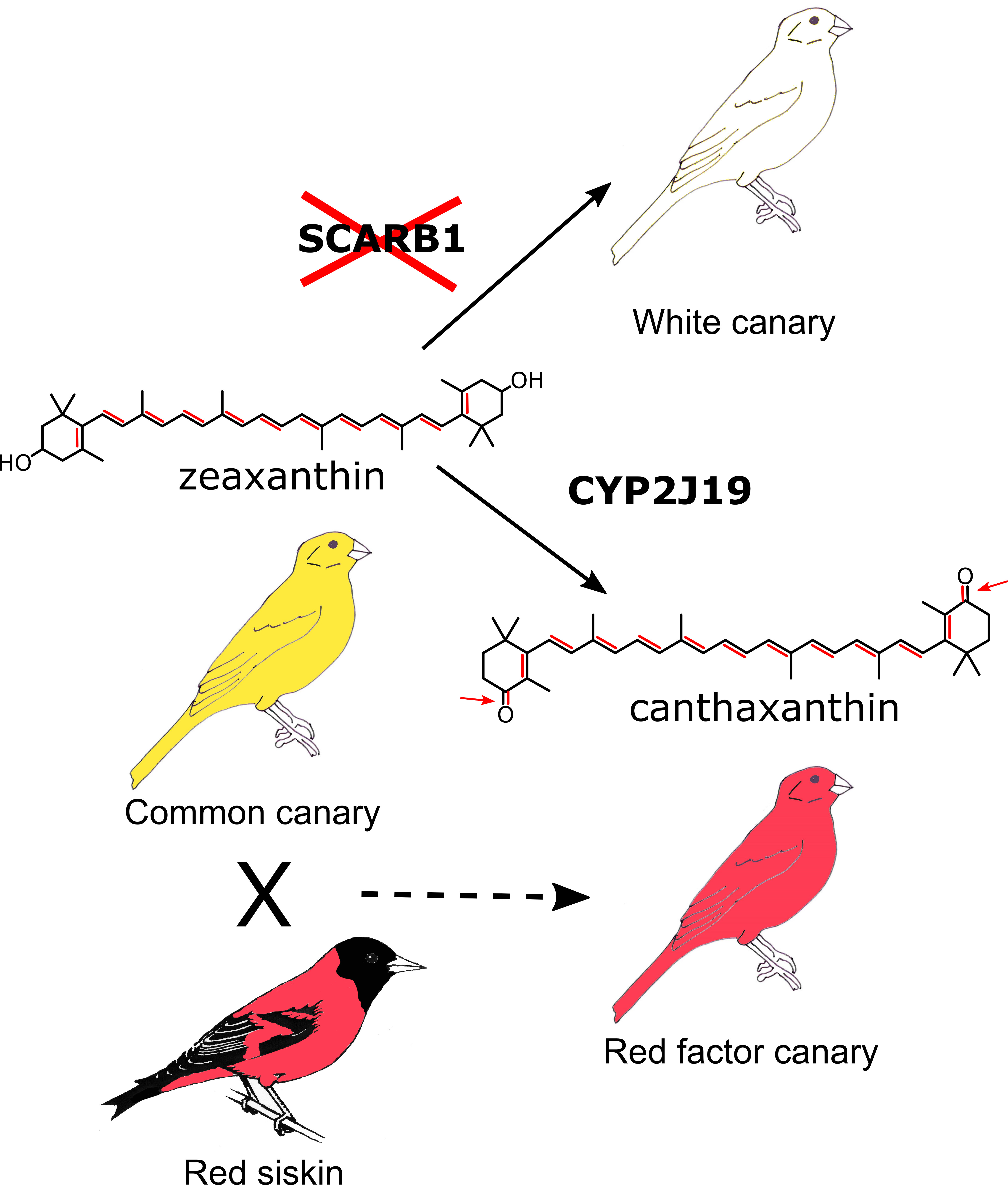Research
We
use integrative approaches to discover the physical, biochemical, and
molecular bases of traits and leverage this knowledge to understand the
adaptive potential of animals. We use carotenoid pigments as a window
into the complex systems of vertebrate visual ecology. Most animals
cannot produce carotenoids themselves and must acquire them from their
diet; however animals are able to modify the molecular structure of
carotenoids to serve specific functions. This is a recurring theme in
the Toomey lab where we investigate three essential roles of
carotenoids in the visual ecology of animals. 1) Carotenoid derived
molecules absorb light to initiate phototransduction within the
photoreceptors of all vertebrates. 2) Carotenoids function as accessory
spectral filters that fine-tune the sensitives of photoreceptors. 3)
Animals use carotenoid pigments to produce colorful visual displays.
1. Visual system adaptation through visual pigment chromophore switching
In aquatic environments, the spectrum of available light can vary dramatically with water quality, depth, and time of year. Many aquatic organisms have adapted to these conditions by rapidly shifting the spectral sensitivity of their photoreceptors. Recently, I was part of a team at my postdoctoral institution that used transcriptome profiling, molecular genetic manipulations, biochemical, and behavioral assays to discover the enzyme (CYP27C1) that modifies the visual pigment chromophore to produce these rapid shifts in visual sensitivity. This discovery opens exciting opportunities to understand visual system plasticity and adaptation in the aquatic environment. We have begun to extend these studies to a broader comparative context and recently characterized CYP27C1-mediated sensitivity shifts in the lamprey (Petromyzon marinus) indicating this mechanism is an ancient adaption in the vertebrate lineage.

2. Visual system optimization through carotenoid spectral tuning
Birds have tetrachromatic color vision mediated by four single cone photoreceptors. The spectral sensitivity of these receptors is fine-tuned by precise combinations of opsin-based spectral sensors and carotenoid-pigmented spectral filtering oil droplets within the cells. This system substantially enhances color discrimination abilities of birds and relies on the accumulation specific carotenoid types within the different cone photoreceptors. As a postdoctoral fellow in the Corbo Lab, I have used a variety of molecular genetic and biochemical approaches to elucidate the enzymatic mechanisms of the specific accumulation of carotenoid within the cone oil droplets. My work has shown that ultraviolet vision of birds involves complementary shifts in opsin-based spectral sensors and carotenoid-pigmented spectral filters that together optimize the visual system for color discrimination.
1. Visual system adaptation through visual pigment chromophore switching
In aquatic environments, the spectrum of available light can vary dramatically with water quality, depth, and time of year. Many aquatic organisms have adapted to these conditions by rapidly shifting the spectral sensitivity of their photoreceptors. Recently, I was part of a team at my postdoctoral institution that used transcriptome profiling, molecular genetic manipulations, biochemical, and behavioral assays to discover the enzyme (CYP27C1) that modifies the visual pigment chromophore to produce these rapid shifts in visual sensitivity. This discovery opens exciting opportunities to understand visual system plasticity and adaptation in the aquatic environment. We have begun to extend these studies to a broader comparative context and recently characterized CYP27C1-mediated sensitivity shifts in the lamprey (Petromyzon marinus) indicating this mechanism is an ancient adaption in the vertebrate lineage.

2. Visual system optimization through carotenoid spectral tuning
Birds have tetrachromatic color vision mediated by four single cone photoreceptors. The spectral sensitivity of these receptors is fine-tuned by precise combinations of opsin-based spectral sensors and carotenoid-pigmented spectral filtering oil droplets within the cells. This system substantially enhances color discrimination abilities of birds and relies on the accumulation specific carotenoid types within the different cone photoreceptors. As a postdoctoral fellow in the Corbo Lab, I have used a variety of molecular genetic and biochemical approaches to elucidate the enzymatic mechanisms of the specific accumulation of carotenoid within the cone oil droplets. My work has shown that ultraviolet vision of birds involves complementary shifts in opsin-based spectral sensors and carotenoid-pigmented spectral filters that together optimize the visual system for color discrimination.

3. Visual
signal elaboration through carotenoid metabolism
In
addition to their role in vision, carotenoids are the basis of
brilliant plumage coloration that plays an important role in mate
choice and antagonistic signaling in many bird species. In
collaboration with Dr. Miguel Carniero (Univ. of Porto, Portugal) and
Dr. Geoff Hill (Auburn Univ.), we have identifed a receptor
essential for the uptake of carotenoids (SCARB1)
and an enzyme (CYP2J19) that mediates the expression of red plumage
coloration in birds.
These discoveries offer opportunities to address long-standing
questions of signal function, sexual selection, and avian
diversification with a new level of mechanistic detail.

